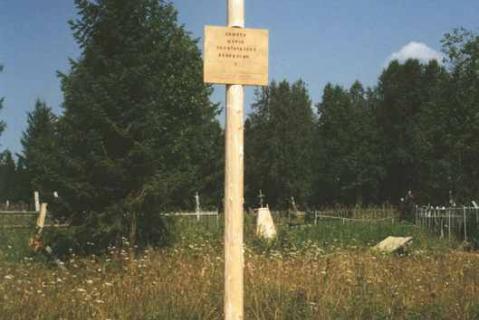At the beginning of 1930 the labour settlement at Sukhaya was set up by dekulakized peasant families – Russians, Belorussians and Ukrainians. (The Kirov Region Book of Remembrance lists members of the Mylnikov family who were deported in 1931; several more were born in the settlement.)
Later they were joined [displaced] by Latvia, Estonian and Soviet German deportees. As of 1939 they came under the Solikamsk district special NKVD commandant. Information from national and regional archives states that there were 489 forced settlers (133 families) at Sukhaya on 1 July 1939. Four years later, in 1943 there were 388 individuals making up 127 families.
It is not known when the settlement closed down officially. Between the 1930s and 1950s those forced settlers and deportees who died were buried in a separate cemetery in individual graves. Their total number is unknown. On 22 July 2004 members of Perm Youth Memorial Society taking part in the “Rivers of Memory” expedition raised a 3-metre-high commemorative cross in the cemetery with a wooden board that reads: In Memory of the Victims of Political Repression. To the forced settlers of Sukhaya village, 1930s to 1950s). The memorial was designed by Robert Latypov. Today the inscription is hard to read and needs renovation.
From the late 1920s to the mid-1950s “Special” settlers were distributed, at various times, to over eight hundred factories or special settlements in the Perm Region (renamed Molotov Region, 1940-1957). More than fifty of these locations were in the Alexandrovsk district.
The information below was assembled by Alexander Chernyshov of Perm Memorial from local and national archives and the information centre of the region’s Internal Affairs department.
Today (August 2025) the assembled and expanding information about “special settlements” in the Alexandrovsk district of the Perm Region is published online in a section of the Centre for Historical Memory.
The Memorial online database (2025) names 45,916 victims of political terror in the Perm Region. (See Perm cemetery.)
Over 16,000 were sent to the camps; and a thousand deported from the Region. Police records list a further 10,244 deported to the Perm Region from other parts of the USSR: 3,390 “kulaks”, 3,588 Soviet Germans and 2,515 from the Crimea (including almost one thousand Crimean Tatars).
| Date | Nature of ceremonies | Organiser or responsible person | Participants | Frequency |
|---|---|---|---|---|
|
nk
|
Civil rites and Commemorative Services
|
nk
|
nk
|
From time to time
|
| State of burials | Area | Boundaries |
|---|---|---|
|
Some grave-markers have survived
|
not determined
|
not delineated
|
[ Original texts & hyperlinks ]
Youth Memorial Archive (Perm)
A. Pykhteyeva, “The Sukhaya settlement on the Yaiva river, Alexandrovsky district”, Uraloved, 21 September 2016 [retrieved, 28 May 2022; no longer accessible, August 2025]
“A temporary memorial in Sukhaya village, Alexandrovsky district”, Perm section of the International Memorial society [retrieved, 28 May 2022]
*
Reply by Perm Region Ministry of Culture, Youth Policy & Mass Communications (27 March 2014) to a formal enquiry from RIC Memorial (St. Petersburg)

